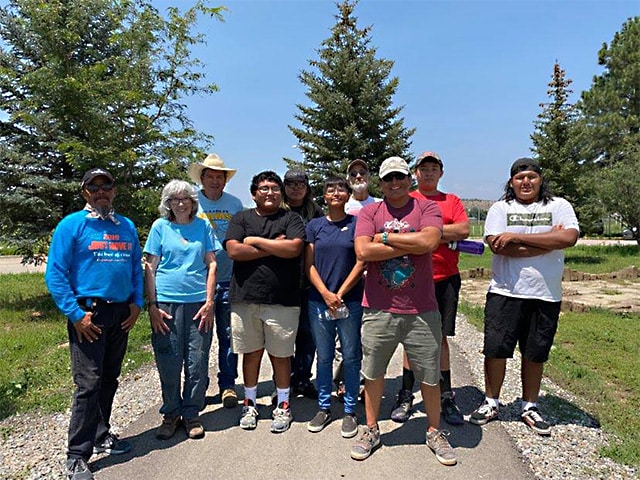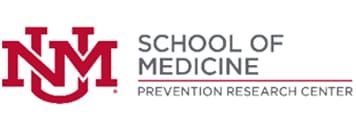University of New Mexico Prevention Research Center
Populations of Focus: rural and frontier communities, Hispanic people, Navajo Nation and Native American populations in New Mexico, Spanish-speaking immigrants
Topic Areas: health equity, chronic disease prevention, well-being
Introduction, Mission, and Vision
The University of New Mexico Prevention Research Center (UNM PRC) is one of 26 Prevention Research Centers (PRCs) supported by the Centers for Disease Control and Prevention (CDC) for the 2019–2024 funding cycle. Each PRC is funded to establish and maintain their center and to conduct a core research project. PRCs may receive supplemental funding to conduct additional research projects and activities.

Young people and sponsors from the Navajo Nation summer youth program pictured with the mayor of the Village of Cuba, New Mexico.
UNM PRC works to improve the health and well-being of underrepresented populations in New Mexico through community-engaged research focused on health promotion and disease prevention. It uses rigorous science, multidisciplinary teams, and diverse partners to develop, study, translate, and implement community interventions into practice.
UNM PRC works to conduct research that is inclusive, respectful, culturally appropriate, and economically and geographically feasible. It recognizes that racism against Black, indigenous, and Hispanic populations and other people of color is a public health crisis that requires immediate action.
UNM PRC’s research also takes into account that New Mexico is a state where people of color make up most of the population. As a federally designated Hispanic-Serving Institution, UNM is uniquely equipped to address issues facing the state’s Native American populations.
“UNM PRC provides a unique view and understanding of prevention research and practice in Native American and Hispanic populations in a rural and frontier state,” said Sally Davis, PhD, founder and director of UNM PRC.
Core Research
Each PRC uses a community-engaged approach to conduct one primary applied public health prevention research project called a core research project. Project activities include design, development, implementation, evaluation, and dissemination. PRCs use at least 50% of their CDC funding to conduct the project in partnership with communities.
Healthy Places–Healthy People
UNM PRC’s core research project for the 2019–2024 funding cycle will focus on a program designed to increase physical activity in the Navajo Nation in New Mexico. It is an expansion of a model program developed by UNM PRC called VIVA—Step Into Cuba. This evidence-based program promoted physical activity in the rural village of Cuba, New Mexico, by developing sidewalks, paths, trails, social support, and opportunities for lifestyle change. It is based on physical activity recommendations from The Community Guide, such as increasing access to places to be active in the natural environment.
During the 2014–2019 funding cycle, UNM PRC worked with partners across the state to implement an expanded and refined version of the program called VIVA Connects in 31 other rural and frontier communities.
Healthy People–Healthy Places builds on these earlier efforts to create opportunities for students, faculty, and staff of Diné College and Navajo Nation Technological University to participate in workshop, training, implementation, and evaluation activities. For the current project, UNM PRC is providing training, workshops, and health education; identifying resources; sponsoring events; creating maps and walking guides; and providing other technical assistance as needed. The goal of the project is to increase access to and awareness of different ways to be physically active across the Navajo Nation.
UNM PRC is also adapting and studying strategies for project implementation and sustainability in 10 Navajo Chapters (communities). It will use mixed methods to determine the processes and successes of Healthy Places–Healthy People. Key instruments and documents are being translated into the Navajo language for the 25% of the population who are most comfortable speaking in their native language.
Additional Research
PRCs may receive supplemental funding to work on additional research projects each funding cycle. These Special Interest Projects (SIPs) focus on a variety of health topics or gaps in scientific evidence. PRCs can also conduct additional research as part of SIP Thematic Research Networks, which are groups of PRCs working together on related health topics.
PRC Vaccine Confidence Network (PRC VCN)
In April 2021, CDC funded a 12-month award to all 26 PRCs to form the PRC VCN in support of the agency’s Vaccinate with Confidence strategy for COVID-19. As part of this network, UNM PRC is examining vaccine hesitancy to find ways to promote vaccine confidence, increase vaccine uptake, and reduce disparities in Latinx and rural populations in Albuquerque, New Mexico. The goal to reduce the incidence of COVID-19 in the United States.
UNM PRC’s strategy includes collaborating with community partners to conduct key informant interviews, listening sessions, and surveys to gain insight into vaccine hesitancy.

Location: Albuquerque, New Mexico
Principal Investigator: Sally Davis, PhD
Deputy Director: Theresa Cruz, PhD
Email: prc@salud.unm.edu